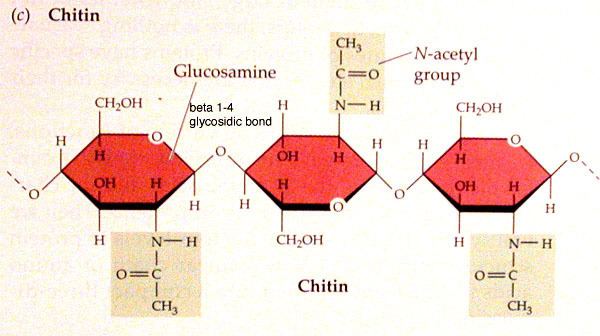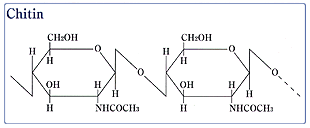Formula (C8H13O5N)n Classification Hexosamines, Biopolymer | Molar mass 203.1925 g/mol | |
 | ||
Cift chitin chitosan film wmv
Chitin (C8H13O5N)n (/ˈkaɪtᵻn/ KY-tin) is a long-chain polymer of an N-acetylglucosamine, a derivative of glucose, and is found in many places throughout the natural world. It is a characteristic component of the cell walls of fungi, the exoskeletons of arthropods such as crustaceans (e.g., crabs, lobsters and shrimps) and insects, the radulae of molluscs, and the beaks and internal shells of cephalopods, including squid and octopuses and on the scales and other soft tissues of fish and lissamphibians. The structure of chitin is comparable to the polysaccharide cellulose, forming crystalline nanofibrils or whiskers. In terms of function, it may be compared to the protein keratin. Chitin has proved versatile for several medicinal, industrial and biotechnological purposes.
Contents
- Cift chitin chitosan film wmv
- Chitin
- Etymology
- Chemistry physical properties and biological function
- Fossil record
- Agriculture
- Industrial
- Medicine
- References

Chitin
Etymology

The English word "chitin" comes from the French word chitine, which first appeared in 1821 and derived from the Greek word χιτών (chiton), meaning covering.

A similar word, "chiton", refers to a marine animal with a protective shell (also known as a "sea cradle").
Chemistry, physical properties and biological function
The structure of chitin was solved by Albert Hofmann in 1929.

Chitin is a modified polysaccharide that contains nitrogen; it is synthesized from units of N-acetyl-D-glucosamine (to be precise, 2-(acetylamino)-2-deoxy-D-glucose). These units form covalent β-(1→4)-linkages (similar to the linkages between glucose units forming cellulose). Therefore, chitin may be described as cellulose with one hydroxyl group on each monomer replaced with an acetyl amine group. This allows for increased hydrogen bonding between adjacent polymers, giving the chitin-polymer matrix increased strength.

In its pure, unmodified form, chitin is translucent, pliable, resilient, and quite tough. In most arthropods, however, it is often modified, occurring largely as a component of composite materials, such as in sclerotin, a tanned proteinaceous matrix, which forms much of the exoskeleton of insects. Combined with calcium carbonate, as in the shells of crustaceans and molluscs, chitin produces a much stronger composite. This composite material is much harder and stiffer than pure chitin, and is tougher and less brittle than pure calcium carbonate. Another difference between pure and composite forms can be seen by comparing the flexible body wall of a caterpillar (mainly chitin) to the stiff, light elytron of a beetle (containing a large proportion of sclerotin).

In butterfly wing scales, chitin is organized into stacks of gyroids constructed of chitin photonic crystals that produce various iridescent colors serving phenotypic signaling and communication for mating and foraging. The elaborate chitin gyroid construction in butterfly wings creates a model of optical devices having potential for innovations in biomimicry. Scarab beetles in the genus Cyphochilus also utilize chitin to form extremely thin scales (five to fifteen micrometres thick) that diffusely reflect white light. These scales are networks of randomly ordered filaments of chitin with diameters on the scale of hundreds of nanometres, which serve to scatter light. The multiple scattering of light is thought to play a role in the unusual whiteness of the scales. In addition, some social wasps, such as Protopolybia chartergoides, orally secrete material containing predominantly chitin to reinforce the outer nest envelopes, composed of paper.
Fossil record
Chitin was probably present in the exoskeletons of Cambrian arthropods such as trilobites. The oldest preserved chitin dates to the Oligocene, about 25 million years ago, consisting of a scorpion encased in amber.
Agriculture
Most recent studies point out that chitin is a good inducer of defense mechanisms in plants. It has also been assessed as a fertilizer that can improve overall crop yields. The EPA regulates chitin for agricultural use within the USA.
Industrial
Chitin is used in industry in many processes. Examples of the potential uses of chemically modified chitin in food processing include the formation of edible films and as an additive to thicken and stabilize foods and pharmaceuticals. Industrial separation membranes and ion-exchange media can be made from chitin. Processes to size and strengthen paper employ chitin and chitosan. Chitosan is prepared from chitin by deacetylation. Researchers have developed a method for using chitosan as a reproducible form of biodegradable plastic and as a promising substrate for engineering human tissues by use of three-dimensional bioprinting.
Medicine
Chitin's flexibility and strength make it favorable as surgical thread. Its biodegradibility means it wears away with time as the wound heals. Moreover, chitin has been reported to have some unusual properties that accelerate healing of wounds in humans. Occupations associated with high environmental chitin levels, such as shellfish processors, are prone to high incidences of asthma. Recent studies have suggested that chitin may play a role in a possible pathway in human allergic disease. To be specific, mice treated with chitin develop an allergic response, characterized by a build-up of interleukin-4-expressing innate immune cells. In these treated mice, additional treatment with a chitinase enzyme abolishes the response.
